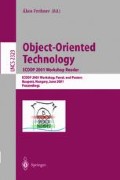Abstract
The history of computer science has shown that decomposing software applications helps managing their complexity and facilitates reuse, but also bears challenging problems still unsolved, such as the assembly of the decomposed features when non-trivial feature interactions are involved. Examples of features include concerns or aspects, black box or white box components, and functional and non-functional requirements. Approaches such as object-oriented and component-based software development, as well as relatively new directions such as aspect-oriented programming, multi-dimensional separation of concerns and generative programming, all provide technical support for the definition and syntactical assembly of features, but fall short on the semantic level, for example in spotting meaningless or even faulty combinations. At previous ECOOPs, OOPSLAs and GCSEs dedicated events have been organised around the aforementioned technologies, where we experienced a growing awareness of this feature interaction problem. However, feature interaction is often merely dismissed as a secondary problem, percolating as an afterthought while other issues are being addressed. The intention of this workshop was to be the first co-ordinated effort to address the general problem of feature interaction in composed systems separately from other issues.
Access this chapter
Tax calculation will be finalised at checkout
Purchases are for personal use only
Preview
Unable to display preview. Download preview PDF.
References
Calder M., Magill E. (editors), Feature Interactions in Telecommunications and Software Systems VI, IOS Press, 2000.
K. Czarnecki and U.W. Eisenecker, Generative Programming, Springer, 2000.
Dini P., Boutaba R., Logrippo L. (editors), Feature Interactions in Telecommunications Networks, IOS Press, 1997.
Theo D’Hondt, Kris De Volder, Kim Mens, Roel Wuyts, Co-Evolution of Object-Oriented Software Design and Implementation, Proceedings of TACT Symposium, Kluwer Academic Publishers, 2000.
University of Glasgow, Feature Interaction Workshop, http://www.cs.stir.ac.uk/mko/fiw00, 2000.
University of Glasgow, The Feature List, http://www.dcs.gla.ac.uk/research/hfig/, 2001.
K. Kang, S. Cohen, J. Hess, W. Nowak, and S. Peterson, Feature-Oriented Domain Analysis (FODA) Feasibility Study, Technical Report, CMU/SEI-90-TR-21, Software Engineering Institute, Carnegie Mellon University, Pittsburgh, Pennsylvania, November 1990.
Kiczales G., Lamping J., Mendhekar A., Maeda C., Lopes C., Loingtier J., Irwin J., Aspect-oriented programming, In Proceedings of ECOOP, 1997.
Kimbler K., Bouma L. G. (editors), Feature Interactions in Telecommunications and Software Systems V, IOS Press, 1998.
Merriam-Webster OnLine, Merriam Webster’s Collegiate Dictionary, http://www.m-w.com/, 2001.
Christian Prehofer, Feature-Oriented Programming: A Fresh Look at Objects, In Proceedings of ECOOP, 1997.
E. Pulvermueller, H. Klaeren, and A. Speck, Aspects in Distributed Environments, In K. Czarnecki and U.W. Eisenecker (editors), Proceedings of the GCSE’99, First International Symposium on Generative and Component-Based Software Engineering, LNCS 1799, Erfurt, Germany, September 2000. Springer.
M. Stefik, Introduction to Knowledge Systems, Morgan Kaufmann Publishers Inc., 1995.
University of Strathclyde, Feature Interaction Group, http://www.comms.eee.strath.ac.uk/~fi/, 2000.
Clemens Szyperski, Component Software: Beyond Object-Oriented Programming, Addison-Wesley, 1998.
P. Tarr, H. Ossher, W. Harrison and S.M. Sutton, N Degrees of Separation: Multi-Dimensional Separation of Concerns, Proceedings of the International Conference on Software Engineering (ICSE’99), May, 1999.
University of Waterloo, Feature Interaction Problem, http://se.uwaterloo.ca/~s4siddiq/fi/, 2001.
Author information
Authors and Affiliations
Editor information
Editors and Affiliations
Rights and permissions
Copyright information
© 2002 Springer-Verlag Berlin Heidelberg
About this paper
Cite this paper
Pulvermueller, E., Speck, A., Coplien, J.O., D’Hondt, M., De Meuter, W. (2002). Feature Interaction in Composed Systems. In: Frohner, Á. (eds) Object-Oriented Technology. ECOOP 2001. Lecture Notes in Computer Science, vol 2323. Springer, Berlin, Heidelberg. https://doi.org/10.1007/3-540-47853-1_7
Download citation
DOI: https://doi.org/10.1007/3-540-47853-1_7
Published:
Publisher Name: Springer, Berlin, Heidelberg
Print ISBN: 978-3-540-43675-1
Online ISBN: 978-3-540-47853-9
eBook Packages: Springer Book Archive

